By Han Pham
As the cool September breezes begin to swirl, they not only signal the back-to-school season but also usher in one of the most culturally rich celebrations in various parts of the world: the eagerly anticipated Mid-Autumn Festival. Held annually on the 15th day of the 8th lunar month, The Mid-Autumn Festival, also known as the Moon Festival, takes on unique cultural significance in each region. In this article, we’ll explore how Taiwan, Korea, and Vietnam honor this cherished tradition.
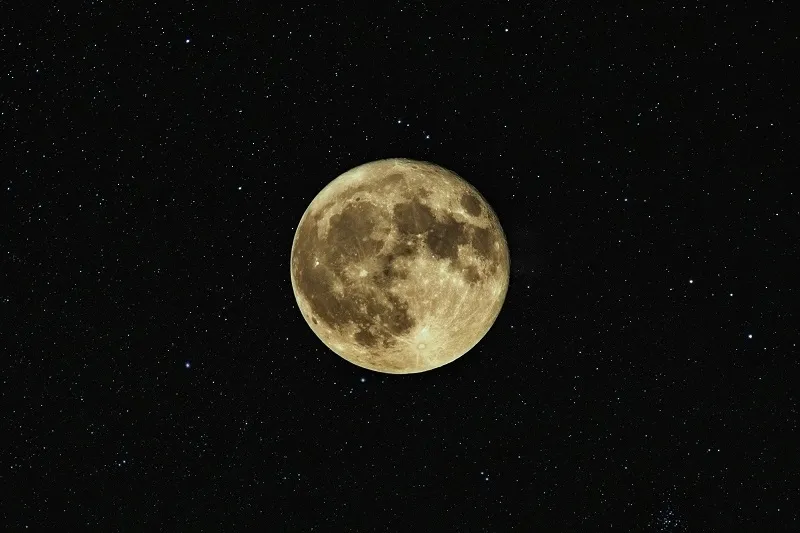
▲Full moon /Photo by Neven Krcmarek on Unsplash
Historical Background and Shared Themes
The Mid-Autumn Festival, a cultural tradition with a remarkable history of over 3,000 years, is celebrated on the 15th day of the 8th lunar month of the Lunar calendar. This auspicious day, when the full moon graces the night sky, typically falls in the Gregorian calendar between mid-September and early October. This ancient culture, believed to have originated in China, marks the most pleasant time of Autumn, with fresh and clean air. The night of August 15, known as the Mid-Autumn Moon, is neither too hot nor too cold, making it the perfect time to bask in the brightest and roundest moon.
Some folklore writers believe that the worship of the moon during the Mid-Autumn Festival originated from the celebration of the harvest season. The festival is a day to thank the earth and ancestors for a bountiful harvest. It's a time to enjoy the fruits of the past season, complete the old year's farming work, and pray for a bountiful harvest in the coming year. The moon is reborn at the new moon, reaches peak vitality on the full moon day, and then disappears at the end of the month, repeating the cycle every month. In agricultural societies, the regeneration of the moon and the regenerative nature of farming are seen as similar processes.
Taking the full moon as the central symbol is a metaphor for completeness. Therefore, the Mid-Autumn Festival is also an occasion for families to gather under the full moon to worship their ancestors and enjoy the bountiful harvest.
One of the most intriguing aspects of the Mid-Autumn Festival is the multitude of legends associated with its origin. From the Moon Rabbit legend found in many places in East Asia to the legend of Chang'e flying to the moon in China and the legend of Agui in Vietnam, each story adds a layer of mystery and fascination to the festival.
As a result, The Mid-Autumn Festival is a time to celebrate the moon and a plentiful harvest. Families come together to show gratitude to their ancestors, indulge in delicious mooncakes, and enjoy the moon's beauty. It's fascinating to see how the festival has taken on unique forms in Taiwan, Vietnam, and Korea, highlighting the incredible diversity of cultural traditions across different regions.

▲ Mid Autumn Festival mooncakes come in various types (source: ALMAZ mooncake)
Variations across countries
Taiwan
The word Mid-Autumn Festival (中秋節) first appeared in "Zhou Li" 《周禮》, pronounced "Zhongqiu" (仲秋), referring to the eighth month of the lunar calendar. In Taiwan, the Mid-Autumn Festival is considered a time to honor family relationships. While the moon remains the central symbol, modern Taiwanese celebrations focus on gathering, feasting, and enjoying time with loved ones. One of the Chinese Mid-Autumn Festival traditions is ancestor worship, and people often have ancestral altars in their homes. On the day of the festival, "three animals" (三牲) and "three vegetables" (三素) will be placed on the ancestral tablets. "Three animals" refers to chicken, pork, and fish, while "three vegetables" refers to three types of fruit. There is no specific definition of which fruit. In some regions of Taiwan, the Mid-Autumn Festival is also a time to honor the earth god, a custom deeply rooted in the agricultural traditions of the island. This practice is a way to express gratitude to the land god for blessing the farmers with a bountiful autumn harvest.
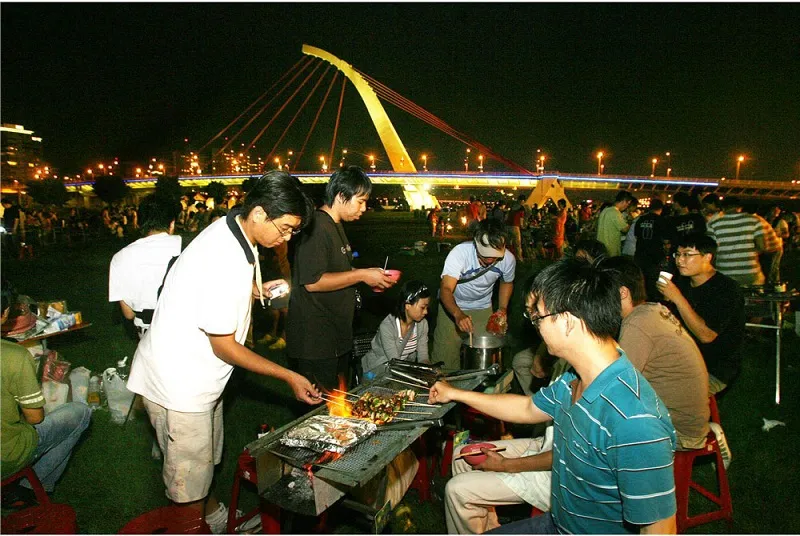
▲Mid-Autumn Festival barbecue was once an important tradition for Taiwanese people to celebrate the festival
(source: Youth Daily News)
Mid-Autumn Festival barbecue became popular in Taiwan in the 1980s, mainly due to the innovative marketing campaign of a Taiwanese soy sauce company, Wan Jia Shan (萬家香 ). Their campaign, promoting family barbecues during the Mid-Autumn Festival with the slogan "One family's barbecue spreads fragrance to thousands of homes" (一家烤肉萬家香), cleverly tied the barbecue theme to the traditional family gatherings and feasting associated with the festival, encouraging people to use their soy sauce for grilling. The practice spread quickly across Taiwan, and now, having a barbecue with family and friends has become a beloved way to celebrate the Mid-Autumn Festival. Although barbecuing during the Moon Festival doesn't have ancient cultural roots, it aligns with family, gathering, and celebration themes. Relatives and friends often come together during the holiday, and outdoor barbecues have become a fun and social way to bond. The smoky aroma of grilled food, shared outdoors under the full moon, adds to the festive atmosphere.
Along with barbecue and mooncakes, Taiwanese people will eat pomelo during the Mid-Autumn festival. After they finish the pomelo, they will wear its peel as a hat, a tradition that symbolizes respect for customs and a sense of continuity to bring good fortune to the family. The elderly believe that Chang'e ‘s favorite fruit is pomelo, and while she is on the moon, she will have better consideration for those who wear pomelo hats and will more likely answer their prayers and bless them with good fortune for the year. Under the moonlight, the Mid-Autumn Festival also allows parents to tell their children stories about Chang'e, the Jade Rabbit, and Wu-Gang, as I mentioned earlier.
Vietnam
Mid-Autumn Festival (Tết Trung Thu), also known by many names such as Tết Trông Trăng, Tết Đoàn Viên or Tết Hoa Đăng, is an important traditional festival that Vietnamese people await. Despite its Chinese origin, The Vietnamese Mid-Autumn Festival has developed into a family holiday, mainly for children. During the Mid-Autumn Festival, according to Vietnamese customs, adults often organize parties for children. They buy or make candle-lit lanterns to hang in the house and let children participate in lantern parades. Elders also give children toys such as masks, lanterns, and tò he (edible toy figurines). Under the moonlight, families gather and organize a feast on this holiday to watch the Moon, eat moon cakes, and drink tea. And when the moon is high, children sing and dance while watching the full moon. In some places, people also organize lion dances or dragon dances for the children to enjoy. In the past, Vietnamese people also held trống quân (military drum) singing and hung kéo quân lanterns during the festival. The drums are sung to the rhythm of three "thình, thùng, thình".
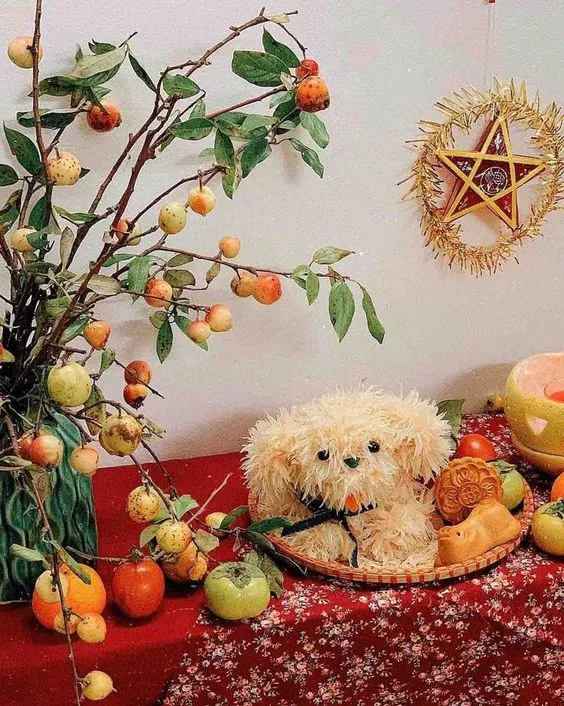
▲Vietnamese Mid-Autumn Festival Tray
The Mid-Autumn Festival’s specialties (usually moon cakes, candies, sugar canes, pomelos, and other fruits) are often displayed on a Mid-Autumn Festival Tray (Mâm cỗ), the centerpiece of which is a dog made from pomelos segments with eyes making from black beans. Dealing out this tray and joining a lantern parade are always the children's favorite parts. In some rural areas, where the neighborly relationship is closer, people often organize for children to carry lanterns through villages, hamlets, and neighborhoods on the night of the Mid-Autumn Festival. Lanterns made of cellophane paper with various colors and shapes, such as stars and carp,etc. along with the bright torch of the leader following the children wandering around the alleys and singing the Mid-Autumn Festival song, have become precious memories of many Vietnamese people. Some areas even have a lantern competition hosted by local authorities or youth groups in the village. Participants will compete to see which lantern is the biggest or most beautiful in the lantern procession. There are many songs in Vietnam for children about this lantern procession; each one has a solid festive atmosphere. And if you are interested, here is the song I recommend Chiếc Đèn Ông Sao (Thu thanh trước 1975) | Hà Nội Vi Vu Rước đèn tháng tám
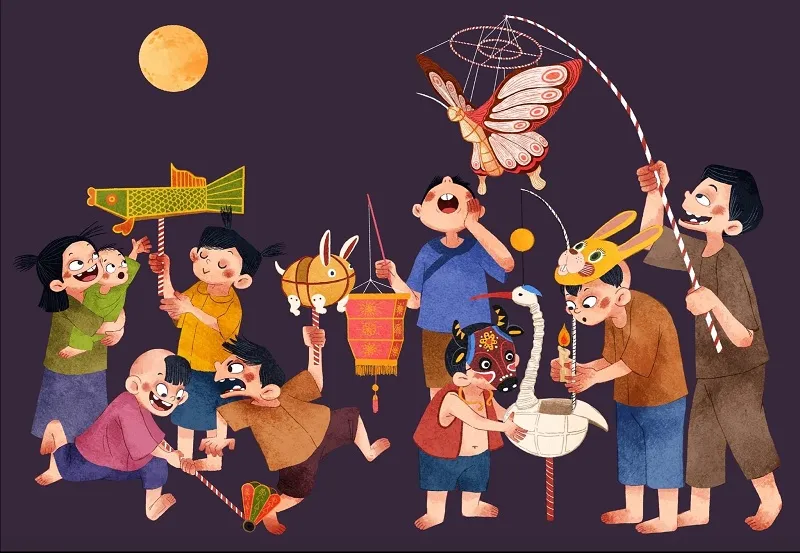
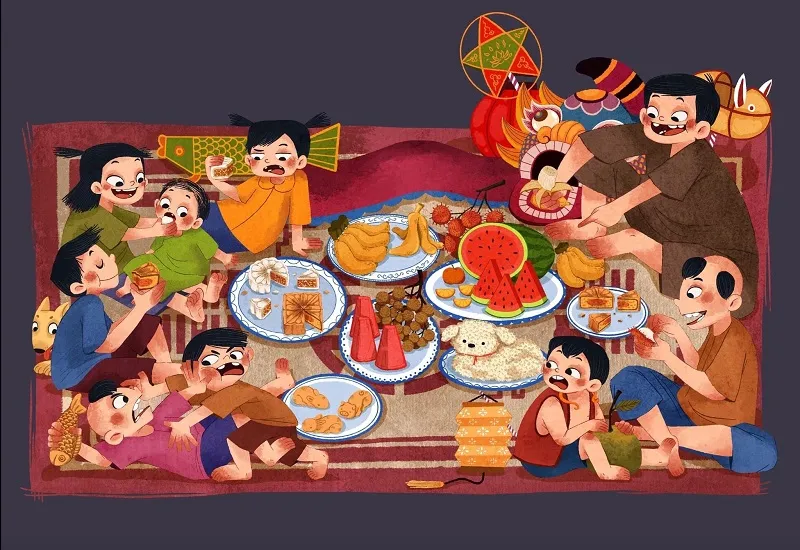
▲Illustration of Vietnamese traditional activities on Mid-Autumn Festival (source: Jade Le - Illustrator)
Whole moon worship is also an activity on this holiday. In addition to the well-known Chinese legend of Chang'e, the Vietnamese have their own moon-related folktale called Chú Cuội trên Cung trăng (the Moon boy). The tale of Chú Cuội is about a woodcutter who discovers a magical banyan tree with healing powers. One day, the banyan tree floats into the sky due to his wife's mistake. Desperately holding onto the roots, Chú Cuội is carried to the moon, where he becomes stuck. Children believe that they can see the image of Chú Cuội sitting under a banyan tree when they look at the moon and hear this story.
Korea
In Korea, the Mid-Autumn Festival is called Chuseok (추석). It is one of the three major holidays in Korea, along with the Lunar New Year (Seollal설날) and the Duanwu Festival (Dano단오). Chuseok (“秋夕) means the most beautiful moonlit autumn night.
The Mid-Autumn Festival is a significant holiday in Korea, marked by various customs and officially recognized as a public holiday. It is an occasion for Korean people to express gratitude to their ancestors for their assistance in achieving a prosperous harvest and to pray for another bountiful harvest in the coming year. During this holiday, all Koreans typically enjoy a three-day break, farmers celebrate the previous harvest, and individuals living far from their hometowns make visits to reunite with their families and share traditional meals.
During Chuseok, Korean families come together to honor their ancestors with the Beolcho (벌초) and Seongmyo(성묘) rituals. They clean the graves, make offerings of fruits and grains, and gather to perform the Charye memorial rituals. This tradition reflects the Koreans' deep respect and gratitude for their ancestors and the importance of family unity and filial piety. Early in the morning of the first day of Chuseok, the entire Korean family will also gather in the main house, where the ancestral altar is set up, to perform the Charye (차례) memorial rituals - Ancestral Worship Ceremony. Charye is held twice a year during Seollal (New Year) and the other during Chuseok.
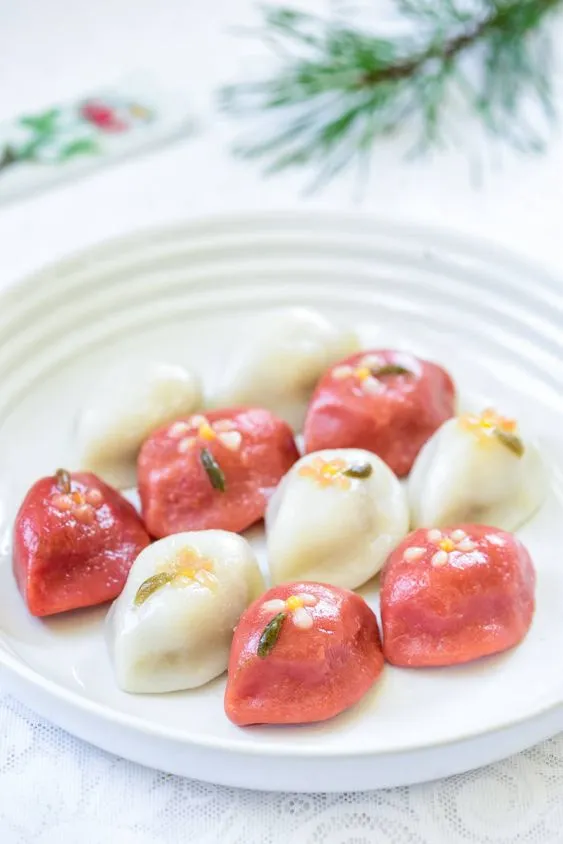
▲Songpyeon is a must-have rice cake for Korean Chuseok holiday. (source: Korean Bapsang)
Chuseok usually falls when the showers and hot weather of summer gradually end. Instead, the cool autumn weather signals the approaching harvest season. Chuseok is a festival to celebrate the bountiful harvest when fruits and grains are abundant. People will use newly harvested rice to cook white rice and make rice cakes and wine. The most notable difference is the traditional dishes of Koreans on this holiday. Songpyeon (송편) is an indispensable dish during Chuseok. This is a typical cake made from new rice flour, non-sticky rice, with sesame, beans, and red beans filling. If moon cakes are made in a round or square shape, Songpyeon is shaped into a crescent. It is called Songpyeon because Koreans often use pine needles when steaming the cake. The cake is shaped like a crescent moon with the wish to bring every family a bright and prosperous future. In addition to Songpyeon, Toranguk (토란국) - Taro soup is also an indispensable dish during the Korean Mid-Autumn Festival. Taro is often stewed with beef tendon or beef brisket to create a light taste. Finally, Baekju (백주) - White wine, during this holiday to gather and eat with family and friends, in addition to the usual Soju, the Chuseok party cannot lack the flavor of white wine. White wine is often brewed and fermented from newly harvested rice in the just-ended crop.
During the Mid-Autumn Festival in Korea, the atmosphere is filled with the joyous sounds of traditional games and activities. People come together to participate in exhilarating games like Tug of War (Juldarigi 줄다리기) and Wrestling (Ssireum 씨름). As the moonlight illuminates the night, a sense of unity fills the air as individuals join hands to form a circle. Within this circle, they sing and dance together, engaging in the beautiful and rhythmic tradition known as Ganggangsullae (강강술래).
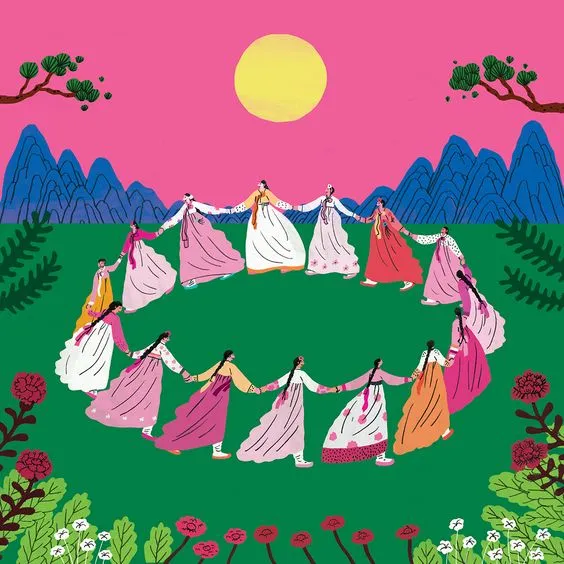
▲illustration of Ganggangsullae (강강술래) (source: Hye Jin Chung Illustration)
In conclusion, the Mid-Autumn Festival is a vibrant celebration of the full moon, family, and gratitude that takes on diverse and meaningful forms across Taiwan, Vietnam, and Korea. From Taiwanese barbecues and pomelo hats to Vietnamese lantern parades and Korean ancestor rituals, each culture adds its own unique twist to this ancient tradition. Despite the differences, the shared themes of reunion, thanksgiving, and joy unite these celebrations under the glow of the same bright moon, highlighting the beauty of cultural diversity across East and SouthEast Asia.